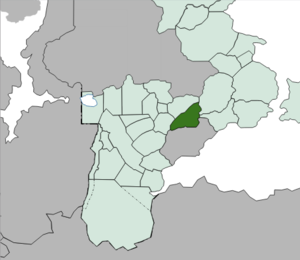Anaqua Territory
| Anaqua Territory Skírēn Anakúa Анакуўа ну Ғодўсу Въакасси Исакимо | |
Flag | |
 Location | |
| Country | Mid-Atrassic States |
| Capital | Anaqua |
| Population | est. 450,000 |
| Managing Commissioner | Xuthus Térunbuir |
| Deputy Commissioner | Madawask Kennebec |
| Legislature | Legislative Council |
| Advisory Council seats | 4 |
| Official languages | Coscivian Chapatec |
| Postal Abbreviation | ANQ |
| Time Zone | West Crona Time |
The Anaqua Territory (Coscivian: Skírēn Anakúa) is a federal subject of the Mid-Atrassic States. It contains the city of Anaqua, which serves as the Mediatrassic capital.
History
During the Chapatec War of Independence and the concomitant breakup of Nanzitolclatl, the area of the future Anaqua Territory was the first part of Nanzitolclatl outside of the Chapazco Department to be captured and occupied by Kiravian and Chapatec separatist forces. The invasive powers subsequently set up a military administration under the name of the Anaqua Joint Security Area. A civil administration for the area was organised in 21207.
In 2034 AD, the Kiravian Stanora passed the Atrassic Crona Governance Act, which consolidated Mid-Atrassic Crona and Upper Atrassic Crona to form the Mid-Atrassic States and designated Anaqua City as the capital of the merged entity. Under a treaty negotiated between the Chapatec Free State and the Kiravian Federacy before the Act was to take effect, the Free State relinquished its remaining treaty rights over Anaqua, retaining extraterritorial jurisdiction over CPLA military sites and Chapatec civilian settlements erected during the joint administration. The Executive Council of the Mid-Atrassic States subsequently reörganised the Anaqua Joint Security Area as the Anaqua Territory.
Geography
Government
The apex governmental body in the Anaqua JSA is the five-member Joint Control Commission (Lódriārikorkirstuv). Two members are nominated unilaterally by the Governor-General of Mid-Atrassic Crona, two by the Government of Chappaqua, and one agreed to jointly by both governments. The Control Commission internally elects a Managing Commissioner to act as procedural chair and spokesman, and Deputy Managing Commissioner. A Chief Administrative Officer selected by the JCC oversees the day-to-day workings of the government.
The bureaucratic apparatus is staffed by officers of the Cronan Administrative Service.
A civil police force has yet to be established. Policing and public security are the responsibility of the Kiravian Army and Chappaqui People's Liberation Army troops stationed in the JSA.
There are currently no elections or elected institutions in Anaqua, though there are plans to introduce purely consultative municipal boards of selectmen for colonial settlements and area-wide Representative Conference by 21212, with the latter to be upgraded into a Legislative Conference with some political power by 21216.
Legal status
Prior to the proclamation of the General Government of Mid-Atrassic Crona, the Anaqua Joint Security Area functioned as a de facto condominium of the Kiravian Federacy and Chappaqua. Since becoming subsumed into Mid-Atrassic Crona, Anaqua is agreed to have become subordinated to Kiravian paramountcy, though the Chappaqui government continues to enjoy certain rights with regard to the area, including the appointment of Control Commissioners, full economic access, and visa-free travel for Chappaqui nationals.
Demographics
Most of the area covered by the Anaqua JSA was traditionally part of the Shenango tribal homeland. However, during and after the war, large numbers of Shenango people were evacuated to other parts of Mid-Atrassic Crona and have not been returned. Since the establishment of the Joint Security Area, large numbers of Coscivians and Chappaqui have moved into the area as part of the Joint Development Programme. Most of these new arrivals are concentrated in the city of Anaqua, though smaller settlements are being built in other parts of the territory.
Settlements
Colonial (Kiravian and Chappaqui) settlements in the Anaqua JSA include:
- Anaqua - Capital and largest city. Estimated population: 5,300
- Fort Mérovin - Kiravian Army base
- Króatan - Evacuated Shenango town, in the process of repopulation by Tínoran Coscivian transplants from Ventarya and Trinatria.
- Kukamónka Ranch Estates - Planned settlement, populated mainly by West Coast Marine Coscivians from Argévia and Metrea.
- Cnóc Abhaile - Gaelic-speaking Movement Settlement founded by emigrants from Kintyre.
- Fort Hyannis - CPLA base
- Independence City - Chappaqui civilian settlement. Estimated population: 563
- Kalmia - Kiravian agricultural settlement.
Major indigenous settlements that remain populated include:
- Pammutan - Pop. ~7,200, chiefly Shenango
- Pyśoakàn - Pop. 5,600, Sazerac
- Aqqomak - Pop. ~4,300, Shenango
- Sendembak - Pop. ~4,200, Shanango
- Snakapaqua - Pop. ~3,900, chiefly Luengo
Economy
The economy of the Anaqua Area is growing rapidly. Kiravian governmental and military establishments in the area have contributed to a demand for goods, services, and housing, and the area's status as the most politically stable and best-secured part of Mid-Atrassic Crona has made it an important gateway for overseas companies looking to gain a foothold in the markets of Northern Crona as the Deluge opens up new markets on the colonial frontier.
Defence, transportation, construction/land development, government, and agriculture are the leading sectors of the Anaquan economy.